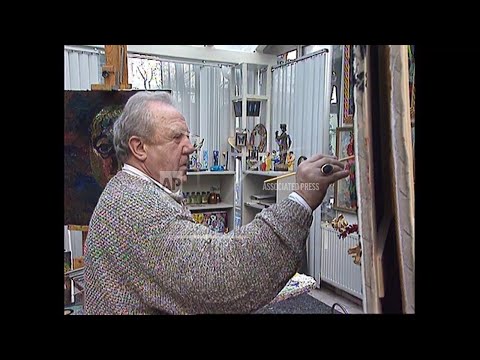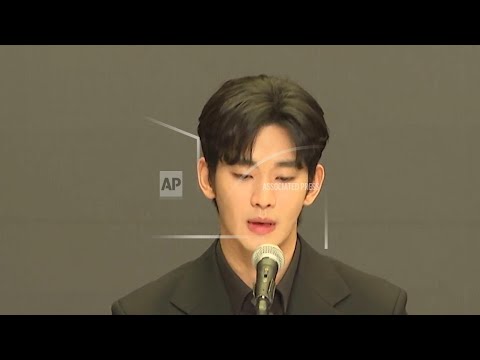(22 Apr 2025)
ASSOCIATED PRESS
Moscow 22 – 25 November 1996
++4:3 MATERIAL++
1. Mid Tsereteli cutting ribbon at opening ceremony of "Fairy Tale Tree" statue at Moscow Zoo
2. Mid Tsereteli surrounded by adults and children at opening ceremony
3. Wide Victory Park, Tsereteli sculpture and obelisk in distance
4. Wide sculpture of St George slaying the dragon at base of obelisk
5. Wide huge sculpture of Peter the Great being erected on Moscow River
6. Close Peter the Great’s head
7. Wide Tsereteli in studio painting portrait of bearded man
8. Mid Tsereteli at easel
9. Close Tsereteli’s hand
10. SOUNDBITE (Russian) Zurab Tsereteli, artist:
"We really need to develop it (this creativity) so that things are better for the next generation. Not so that people are always asking ‘Why does Zurab Tsereteli work so much?’ Can you imagine I have five sculptures in America and no-one says to me ‘Zurab why have you got five sculptures in America?’ They’re grateful to me."
ASSOCIATED PRESS
Moscow – 2 April 2004
11. Mid entrance to Tsereteli’s studio and compound with Putin statue at the entrance
12. Close feet of Putin statue, pan up
13. Mid Zurab Tsereteli
14. Mid Tsereteli’s statues
STORYLINE:
Zurab Tsereteli, a prominent Georgian-Russian sculptor known for colossal, often controversial, monuments, died early on Tuesday at 92.
His assistant Sergei Shagulashvili told Russia’s state news agency Tass that Tsereteli suffered cardiac arrest.
Tsereteli was born on January 4, 1934, in Georgia, which was part of the Soviet Union at the time, in the capital Tbilisi.
In the 1970s, Tsereteli became an art director with the Soviet Foreign Ministry, traveling the world and decorating Soviet embassies. In between, he worked on Mikhail Gorbachev’s summer house in Abkhazia.
“I don’t know why they chose me,” he said in a 2013 interview. “But I went through a good school – maybe that’s why. A school that synthesised architecture and monumental art! I had good teachers.”
In 1989, a monument designed by Tsereteli was erected in London. In 1990, another one was unveiled in front of the United Nations headquarters in New York.
After the Soviet Union collapsed in 1991, Tsereteli moved to Moscow and built a rapport with then-mayor Yuri Luzhkov. The relationship guaranteed him regular and lucrative commissions. He designed several squares and two metro stations in central Moscow and put up a dozen massive monuments around the city.
Tsereteli’s distinctive style prompted much criticism over the years, both in Russia and abroad. Critics argued his pieces were too colossal and didn’t fit in the city’s architecture.
One of his most controversial monuments was in 1997 when a 98-meter-tall Peter the Great standing on a disproportionally small ship was erected a block away from the Kremlin, prompting protests from Muscovites.
Tsereteli tried to put up a similar monument of Christopher Columbus in New York. Russian media reported in 1997 that current U.S. President Donald Trump supported his plans at the time, but city authorities rejected them. After being turned down by Columbus, Ohio and Miami as well, the statue found a taker in Puerto Rico.
Russian President Vladimir Putin in 2003 awarded Tsereteli Russian citizenship “for special services to the Russian Federation.”
In 2010, Luzhkov was dismissed as Moscow mayor. The new city administration preferred Western architects to work on ambitious urban projects, and Tsereteli was shifted to the sidelines.
His legacy includes some 5,000 pieces in Russia, Georgia and several other countries.
Find out more about AP Archive: http://www.aparchive.com/HowWeWork
Twitter: https://twitter.com/AP_Archive
Facebook: https://www.facebook.com/APArchives
Instagram: https://www.instagram.com/APNews/
You can license this story through AP Archive: http://www.aparchive.com/metadata/youtube/96da0de38e3a41b39de9b414d6b76827
Author: AP Archive
Go to Source
News post in April 27, 2025, 12:05 pm.
Visit Our Sponsor’s:
News Post In – News





